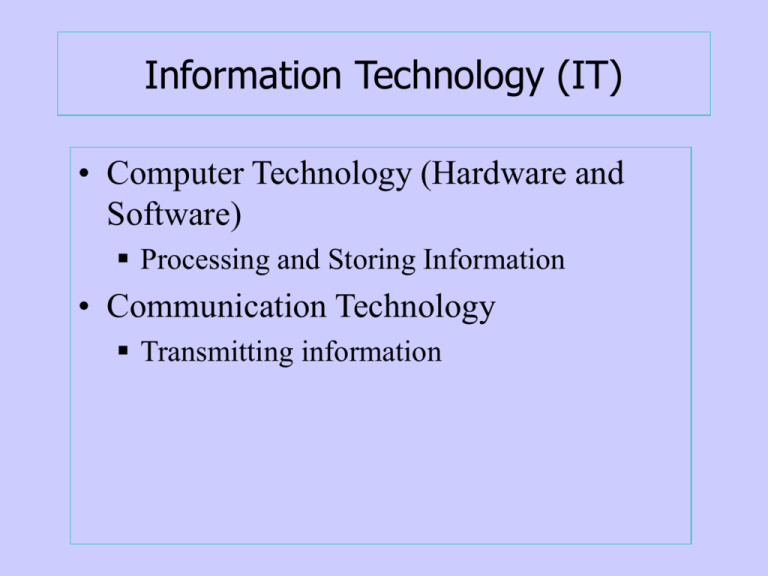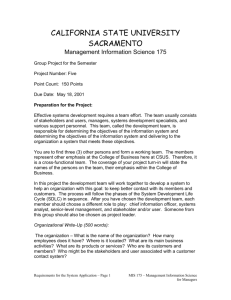Introduction to MIS
advertisement

Information Technology (IT) • Computer Technology (Hardware and Software) Processing and Storing Information • Communication Technology Transmitting information Introduction to MIS • The MIS Concept • System Concepts • Types of Business Information Systems Roles; Trends • Managerial Challenges of IT • Why Studying IS/MIS What You Need to Know The MIS Concept The MIS concept addresses the use of IT to improve individual and organizational performance at two levels: 1) producing “better” tangible outputs 2) developing tools and processes that allow better management decision making Level 1: “Better” Tangible Outputs • IT is used to make the process in producing a tangible output more efficient and more effective • Implication Issues whether or not to use IT selecting the proper IT employing correct procedures for the utilization of the IT Level 2 : Intangible Outputs • A schematic view - the information/decision level • MIS involves identifying the key decisions that are related to reaching objectives, on determining the proper information needed to make these decisions, and on improving the decision processes employed to make the decisions. • Implications: Activity at this level concentrates on developing tools and processes that allow better management decision making The MIS Concept - Level 2: Intangible Outputs (achieving desired objectives) Goals/Objectives Decisions Information Data Decision Processes System Concepts • What is a system? A set of components that interact to accomplish goals Systems can be viewed as process models in terms of their inputs, outputs, processing, and feedback/control mechanisms. Examples. • What is an IS? A set of interrelated components that collect input, process, and output data and information and provide a feedback/control mechanism • What is a CBIS? An IS that uses IT. Components: hardware, software, databases, networks, people, procedures System Examples • University – an example Inputs: students, faculty, textbooks Processing mechanisms: teaching, research, service Output: graduates Goal: acquisition of knowledge • The Manufacturing System • Other Examples • Subsystem, interface, open, adaptive Boundary Feedback A Manufacturing System: Generic Components Environment Feedback Signals Feedback Signals Control Signals Control by Management Control Signals Input of Raw Materials Manufacturing Process Output of Finished Products System Boundary Other Systems Systems: Some Examples • University Inputs: Students, Faculty, Textbooks Processes: Education/Courses Output: graduates Feedback: surveys, grades • Toyota Plant Inputs: raw materials, components Processes: assembly line Output: mini-vans Feedback: customer surveys, quality reports • Fast Food IS Inputs: consumer orders Processes: processing software Output: receipts, cook’s order list Feedback: invalid entry message • Video Store IS Inputs: rentals, returns Processes: processing software Output: reports, rental agreement Feedback: error repots System Classifications and Characteristics Subsystem System Boundary Interface Open, Adaptive Systems Open Adaptive Closed Nonadaptive Input, Processing, Output, Feedback/Control INPUTS Gathering and capturing raw data PROCESSING Converting or transforming data into useful outputs OUTPUTS Producing useful information, usually in the form of documents. Feedback/Control Output that is used to make changes to input or processing activities System Performance Standards: Efficiency and Effectiveness Efficiency: a measure of what is produced divided by what is consumed • an improved product • the same level product produced cheaper or faster • the improvement in the product exceeds the increased cost Effectiveness: a measure of the extent to which a system achieves its goals. • Goal: to reduce damaged parts by 100 units • Q: Actual reduction in damaged parts using a control system is only 85 units. Effectiveness? • A: The effectiveness of the control system is 85 percent What You Need to Know • Foundation Concepts: Fundamental concepts about the components and roles of IS • IT: Major concepts, developments, and management issues in information technologies • Business Applications: The major uses of IS for the operations, management, and competitive advantage • Development Processes: How end users or information specialists develop and implement IS • The challenges of effectively and ethically managing information technologies, strategies, and security at the end user, enterprise, and global levels of a business Ethical Dimensions of IT • What uses of IT might be considered improper, irresponsible, or harmful to other individuals or to society? • What is the proper use of an organization’s information resources? • What does it take to be a responsible end user of IT? • How can you protect yourself from computer crime and other risks of IT? Major Roles of Information Systems Support of Strategic Advantage Support of Managerial Decision Making Support of Business Operations History of the Role of IS 1950-1960 1960-1970 Data Processing Management Reporting Electronic Data Processing - TPS Management Information Systems 1970-1980 Decision Support Decision Support Systems - Ad hoc Reports 1980-1990 1990-2000 Strategic & End User Electronic Commerce End User Computing Exec Info Sys Expert Systems SIS Electronic Business & Commerce -Internetworked E-Business & Commerce Trends in ISs • Data Processing: 1950s Transaction processing, record keeping, traditional accounting applications • Management Reporting: 1960s MIS – predefined management reports for decisionmaking purposes • Decision Support: 1970s DSS – interactive ad hoc support of the managerial decision-making process • Strategic and End User Support: 1980s EUC, Executive Information Systems, Expert Systems, Strategic Information Systems • Electronic Business and E-Commerce: 1990s - The Electronic Business The Internet Suppliers and Other Business Partners Company Boundary Extranets Procurement, Distribution, and Logistics Engineering & Research Manufacturing and Production Accounting, Finance, and Management Intranets Advertising Sales Customer Service Extranets Consumer and Business Customers







